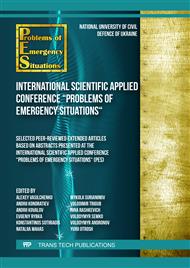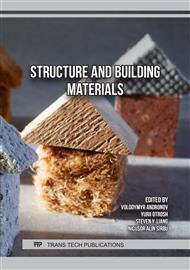[1]
S.S. Kaprielov, G.S. Kardumyan, Novye modificirovannye betony v sovremennyh sooruzheniyah, Beton i zhelezobeton, 2 (2011) 78–82 [in Russian].
Google Scholar
[2]
A.V. Frolov, L.I. Chumadova, A.V. Cherkashin, L.I. Akimov, Ekonomichnost ispolzovaniya i vliyanie nanorazmernyh chastic na svojstva legkih vysokoprochnyh betonov. Stroitelstvo unikalnyh zdanij i sooruzhenij, 19 (2014) 51–61 [in Russian].
Google Scholar
[3]
A. Shishkina, A. Shishkin, Research into effect of complex nanomodifiers on the strength of fine-grained concrete. Eastern-European Journal of Enterprise Technologies, 2(6–92) (2018) 29–33.
DOI: 10.15587/1729-4061.2018.127261
Google Scholar
[4]
V.P. Sopov, A.L. Tkachuk, Vliyanie mineralnyh dobavok na strukturoobrazovanie cementnogo kamnya. Naukovij visnik budivnictva, 66 (2011) 250–254 [in Russian].
Google Scholar
[5]
А. Shishkin, N. Netesa, А. Netesa, Determining the rational compositions of low-strength concretes. Eastern-European Journal of Enterprise Technologies, 1(6–97) (2019) 47–52.
DOI: 10.15587/1729-4061.2019.156599
Google Scholar
[6]
M.N Moroz., V.I Kalashnikov., V.A. Hudyakov, P.G. Vasilik, Vodostojkij melkozernistyj beton, gidrofobizirovannyj nanochasticami stearata kalciya. Stroitelnye materialy, 8 (2009) 55–59 [in Russian].
Google Scholar
[7]
A.V. Nomoev, V.C. Lygdenov, L.A. Urhanova, S.A. Lhasaranov, Melkozernistyj cementnyj beton s nanodispersnym modifikatorom. Nanotehnologii v stroitelstve: nauchnyj internet-zhurnal, 4 (2010) 42–52 [in Russian].
Google Scholar
[8]
A.I. Hristoforov, I.A. Hristoforova, D.I. Kuzmin, Melkozernistyj beton, modificirovannyj organicheskimi soedineniyami Na+. Stroitelstvo i rekonstrukciya, 2 (2011) 104–109 [in Russian].
Google Scholar
[9]
A. Shishkina, А. Shishkin, Application of the easy concentration effect in concrete technology. IOP Conference Series: Materials Science and Engineering, (2020) 907(1) 012038.
DOI: 10.1088/1757-899x/907/1/012038
Google Scholar
[10]
B.V. Deryagin, Itogi issledovaniya svoistv granichnikh sloev zhidkostei i ikh rol v ustoichivosti dispersnikh sistem. Uspekhi kolloidnoi khimii, (1973) 30–38 [in Russian].
Google Scholar
[11]
A.M. Blokh, Struktura vodi i geologicheskie protsessi. Nauka, Moskow, 1969.
Google Scholar
[12]
O.O. Shishkina, O.O. Shishkin, Doslidzhennya vplivu nanokatalizu na formuvannya micnosti reakcijnogo poroshkovogo betonu. Eastern-European Journal of Enterprise Technologies, 1(6–79) (2016) 55–60.
Google Scholar



